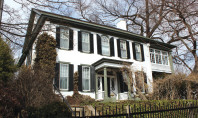The Ancient Jasper Mines of Vera Cruz

Located just south of Emmaus in Upper Milford Township, the tiny village of Vera Cruz is best know as home to some of the oldest jasper mines in North America. According to archeological records, the mines date back to the end of the last ice age and were first opened by Paleolithic people as early as 12,000 years ago.
An incredibly hard opaque stone, jasper is a type of microcrystalline quartz that is commonly found in yellow, brown, green and red varieties. Because of its crystalline structure, jasper tends to fracture along clean, predictable lines – making it ideal for shaping into tools such as arrowheads and knives.
For thousands of years, Native Americans mined the plentiful jasper deposits found in Vera Cruz. Tribes such as the Lenni Lenape, who lived in the Lehigh Valley and surrounding areas until the mid-1700s, excavated the land by systematically digging giant mine shafts, and then setting controlled fires to heat the jasper and force it to break away from the surrounding rock.
After extracting the raw jasper from Vera Cruz, the Lenni Lenape carted it to nearby camps, where it was broken into smaller pieces. From there, the stones were taken to settlements throughout the Lehigh Valley, where skilled craftsmen shaped the pieces into tools through a process known as “flint knapping.” By repeatedly striking the jasper along its natural cracks and fissures, they forced it to flake into sharp, thin edges that were then further shaped into knives,
arrowheads, spear tips, axes and other instruments.
… at Vera Cruz alone they uncovered nearly 100 prehistoric mining pits – many as large as 100 feet across and 50 feet deep.
Aside from using the stone for functional purposes, Lenni Lenape craftsmen also fashioned Vera Cruz jasper into beautiful, highly prized jewelry. The stone’s stunning natural colors and intricate textures were associated with spiritual health and, as a result, it was often used in trade with other tribes. In fact, the jasper was considered so valuable that Native American groups living throughout Pennsylvania, New Jersey and New York would routinely travel hundreds of miles to engage in trade with the Lenni Lenape. Recent archeological studies have even found jasper that originated in Vera Cruz as far away as New England, and credit the jasper trade as being vital to helping connect dozens of different tribes living throughout the American east coast.
But despite playing such an important role in Native American life for hundreds of generations, the demand for jasper sharply declined in the mid-1600s. The introduction of more “modern” tools by European settlers, who arrived in the Lehigh Valley with lighter, sharper and more durable iron and brass, caused a dramatic shift in Native American trade and hunting culture. Within the span of just a few years, the Lenni Lenape stopped mining jasper and instead became heavily engaged in the fur trade in order to acquire these new metals. As a result of this dramatic cultural shift, the jasper mines of Vera Cruz were abandoned by the early 1700s. For the next two hundred years, they sat deserted and unused, a forgotten reminder of the land’s native past.
Finally, in the early 1890s, a team of researchers led by Henry Mercer, the famed Doylestown tile-maker, conducted the first large-scale excavation of the Vera Cruz site. A Harvard graduate and experienced archeologist, Mercer was deeply interested in ancient tool making and was working for the University of Pennsylvania’s museum in Philadelphia
at the time.
Over the next two years, Mercer and his team led in-depth surveys of the quarries both at Vera Cruz and in the surrounding areas. Their work revealed just how widespread the jasper mining had been; at Vera Cruz alone they uncovered nearly 100 prehistoric mining pits – many as large as 100 feet across and 50 feet deep, and some of which still contained the ancient stone and bone tools used during operation.
In 1894, Mercer published his extensive findings in the American Anthropologist journal. His detailed maps and thorough research helped spark interest in the Vera Cruz site and brought about the first formal recognition of the land’s historic significance.
But despite the attention, the Vera Cruz mines could not escape modern development. In the mid-1950s, the construction of the Northeast Extension of the Pennsylvania Turnpike resulted in the destruction of approximately one-third of the ancient mines. Following a public outcry by local residents, a large portion of the remaining site was transformed into the aptly named Jasper Park in the 1960s in an effort to save what was left
of the land.
Today, more than three centuries after the Native American tribes last worked them, Vera Cruz’s jasper mines are difficult to spot. Dirt, debris and undergrowth have filled in the mine’s visible depressions, while erosion and other natural processes have worn away the most obvious signs of their existence. For visitors who come to Jasper Park, the only obvious reminder of the land’s ancient history is a single bronze dedication marker and a statue of Chief Lappawinze, one of the last Lenni Lenape chiefs to live in the area.




















